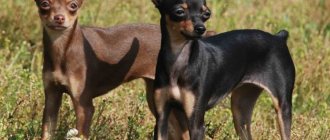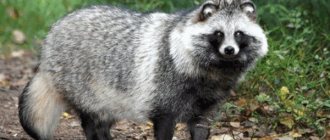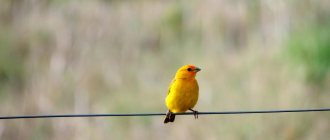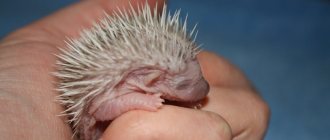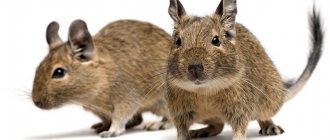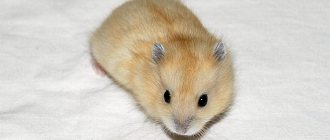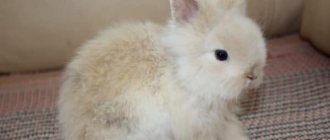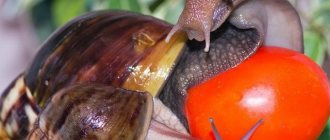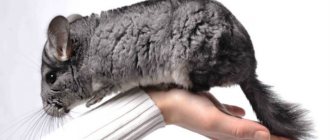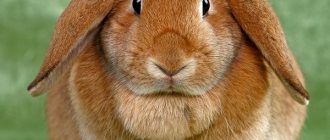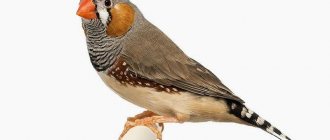Characteristics and description of the breed
Height at withers: 15-23 cm Weight: males - up to 5 kg, females - up to 5.4 kg
- Color: white, black, cream - any, except albino and liver-colored coat
- Coat with decorative fringes on the ears, tail, and in the form of a lush mane.
- The muzzle is short, flattened, and the tail is carried over the back.
- Eye color: dark
- Nose color: black
- General appearance: small stature, strong build, small shiny eyes.
Breed varieties: royal, dwarf and mini Pekingese
There is no official division into subspecies in the breed, but sometimes small puppies are born to two standard parents - “sleeves”. They comply with the standard, with the exception of size, so they do not take part in breeding .
The widespread belief about the existence of a variety of royal and miniature Pekingese is a myth . Similar thoughts arose due to mass crossing with other breeds during the USSR. Then Tibetan terriers were often mixed into them, which resulted in dogs that were taller in the legs with less voluminous hair and a rustic head.
Growth phases
The growth of a young dog consists of the development of anatomy, physiology and the entire range of psychological characteristics and behavioral reactions that characterize the breed. The growth rate of Pekingese is quite high, since puppies of small breeds of dogs acquire the size of an adult much faster. They also reach sexual maturity faster.
Energy expenditure during growth is significantly greater than during adulthood. During the first stage of growth, the puppy develops skeletal bones and develops muscle mass. The growth is extremely intensive.
History of the breed
The ancestor of the Pekingese is called an ancient Chinese dog called “toy” . It was smaller than modern representatives, but the exterior was similar. Mixing the blood of Toys with other dogs of similar sizes led to the appearance of the first Pekingese.
From this moment on, the life of the imperial dogs can be called heavenly. They lived exclusively in the palaces of their generous masters. They had their own minister, spacious bamboo pens with beds, quality care and personal servants. They were decorative dogs; they were not used for service or protection; in temples they were worshiped along with deities.
Pekingese were bred only for rulers and those close to them. Among the common people, fluffy dogs with a specific facial expression were not found. The theft of such pets was severely punished regardless of the status of the offender. Only the emperor had the right to give a puppy.
Chinese culture is famous for its mythical tales. According to one legend, the Pekingese is the fruit of love between a lion and a monkey . When the king of beasts fell in love, he suffered greatly. Buddha helped him and reduced him in size. The winged lion won the favor of the monkey, from which small Pekingese dogs were born.
Small dogs with a short muzzle and long feathering became a real symbol of happiness and prosperity among the imperial dynasties. They were depicted on frescoes, and sculptures with their silhouettes were installed at the palace entrances. The rulers dedicated poems to these aristocrats of the dog world and carried them with them, pressing them to their bodies. They were very angry with the servants if the pets were sick or sad.
The turning point in the history of the breed coincided with the coup d'etat in China. The government was overthrown by the people, numerous bloody uprisings caused the introduction of foreign troops into imperial territory. When the rebels reached the royal mansion, the emperor decided to burn them to the ground. Not only buildings were damaged, but also innocent dogs. The British military managed to save several Pekingese and take the unfortunate animals to Europe.
Thus began a new stage for the breed. In England they were considered very expensive dogs and were presented as valuable gifts. An ordinary person could not buy such a puppy; there were cases when tens of thousands of pounds were offered for a dog, but the owners steadfastly refused to sell their pets.
The British managed to accustom some Pekingese to shepherd service, and they managed to work almost as well as shepherds. But such use contradicts the true purpose of a companion dog. In addition, the structure of the body and respiratory tract of Pekings does not allow them to move for a long time and actively, especially when chasing livestock.
Modern Chinese representatives of the breed are mostly descendants of English dogs . They were imported by enthusiasts after the easing of the government regime in the eastern country.
In 1891, British dog handlers recognized the breed and gave it the name “Pekingese.” They offered other options, for example, “Peking Chin”, “Peking Pug”, “Peking Spaniel”. They were brought to the USSR in the middle of the 20th century. There was a large population in Leningrad and the region. Later, Pekingese became popular and remained at the top of the list of common breeds until the mid-90s.
At the same time there was a change in the breed standard. “Old-type” or Soviet dogs gave way to short-legged and fluffier representatives. However, both groups can participate in exhibitions and have offspring with paperwork.
Dog and man
Pekingese will be the best friends for the following categories of owners:
- Aged people,
- Homebodies,
- Calm and inactive people.
They will definitely not get satisfaction from the content:
- Athletes,
- Hunters,
- Fans of service breeds.
There are debates about behavior in families with children. Much depends on the genetics of a particular dog, upbringing, including the child. An animal with such a temperament may not seem too affectionate , but it will never be the first to offend a baby. In general, Pekings have shown themselves to be calm and balanced dogs.
The attitude towards other pets depends on the hierarchy. However, most Pekingese get along peacefully with cats and other dogs. They lack the hunting instinct , which is reflected in their behavior.
Pekingese are not suitable for outdoor living. They must grow and exist next to a person, although, at first glance, they seem overly independent. The presence of the owner nearby will ensure a healthy psyche for the pet. In addition, they require careful daily grooming due to their coat.
Pekingese nutrition: what is special?
When getting a dog of this breed, think not only about what to feed your Pekingese, but also about how to organize the feeding process. It should be borne in mind that the Pekingese dog is not large in size, so it does not require too many calories, and, therefore, it will be very picky in food and can afford to reject certain treats. Moreover, the Pekingese's excellent thick coat allows it to spend a minimum of energy on thermoregulation, so the dog can easily go without food for a whole day. And if you think that a hungry animal will still eat what it rejected earlier, you are deeply mistaken! By the way, Pekingese puppies very often take advantage of this, using the “hunger strike” as a tool to blackmail the owner.
To prevent this from happening to you, anticipate possible difficulties in advance. You need:
- immediately accustom your dog to balanced and varied food, which you can easily prepare for him (leave delicacies for later, when the animal is already accustomed to a certain diet);
- do not feed your dog food from your table, all of it is at least very salty by dog standards;
- do not give the animal sweets, fatty meats, smoked meats and sausages (feeding this to a Pekingese puppy is especially harmful, as it can subsequently cause serious stomach problems);
- include fruits and vegetables, as well as fermented milk products in the animal’s diet (Pekingese, whose feeding is based on such a “menu”, always feels healthier).
Choosing a nickname
These funny-looking animals are often called imperial names, which over time turn into short forms. Beautiful combinations are obtained with thematic adjectives. Double names are given to Pekingese for entry in the pedigree.
Nicknames for boys: Caesar, Tobby, Dandy, Johnny, Stitch, Max, Simba. Nicknames for girls: Mary, Nymph, Daisy, Prima, Bella, Basya, Fani.
Maintenance and care
Pekingese have a hard time withstanding the heat . They feel better in the cold. Dogs at elevated temperatures can suffocate and develop problems with the heart and blood vessels.
Walks with Beijing dogs are short due to the characteristics of the body. Especially in warm seasons. Half-hour promenades in the morning and evening at a leisurely pace are enough. They should only be worn in very severe frosts, because their undercoat is not very dense. Also, overalls and blankets will come in handy if the street is dirty.
Feeding
Meals should not include food from the human table. Pekings should be fed mainly meat. Bones of any kind are excluded, since the breed has problems with teeth. Periodically they give fruits, vegetables, and a little porridge. Dry food is selected according to weight, age and general condition. Water must be freely available.
Grooming and cutting
grooming is required - frequent brushing of the coat is required. They go over the back and head with a massage brush, and the decorative fur on other parts of the body is combed with a “rake” with long, sparse teeth with rounded ends. You can trim the feathers if they interfere with movement, but you cannot cut your Pekingese's hair for exhibition. Their coat should be coarse, rough to the touch and not prone to tangling. Dirt can be easily brushed off with a brush. If the wool structure is different, then this can be dealt with in two ways:
- Haircut (shaving)
- Using cosmetics for dogs
The first option is undesirable. It is justified in the case of soft wool, which looks like a dandelion. They shave not to zero, leaving a few centimeters of cover. Before grooming, wash, dry and comb the animal. Before bathing procedures, tangles are removed using brushes and by hand using oils.
Pekingese are washed several times a year or when heavily soiled. A care complex of products is selected based on the type of coat. For plump hair - structuring, for hard hair - a standard set of cleaning and nutrition. If tangles form regularly, use conditioners that make your hair smooth.
Pekingese toys
Pekingese are independent and are quite capable of entertaining themselves in your absence. To prevent your dog from getting bored, buy him special toys. Pekingese love balls and various figures made of durable latex that can be chewed and rolled. Toys should not be too big or heavy, otherwise the dog will lose interest in them.
Your pet will also enjoy soft toys made of fabric and faux fur . Make sure that there are no small parts on them that the Pekingese could bite off and swallow.
Pregnancy and childbirth
Pregnancy and childbirth in Beijing sometimes occur with complications . This is due to short stature and body structure. Ideally, the female should be larger than the male to ensure a normal birth process. However, even in this case, a dog with similar parameters has a rather difficult time enduring the second half of pregnancy and childbirth.
Due to breathing and low activity, problems may arise that affect the offspring. She has difficulty walking and getting enough oxygen. Childbirth in Pekingese is often accompanied by surgical intervention due to the large weight of the fetus or weak labor. Then veterinarians decide on a caesarean section or the use of drugs.
Education and training
Small dogs learn too. Sometimes owners neglect this, citing the decorative breed. In most cases, Beijingers are able to learn commands. The training process will be more difficult and longer than with service breeds (German shepherds, Malinois, Dobermans).
A good instructor will help you learn a general obedience course and get a diploma, because one of their main tasks is to “educate” the dog’s owner and teach him how to interact with it.
A Canadian psychologist scientist has compiled data about dogs into a single list. He determined learning abilities by the number of repetitions of commands to execute them. On this list, the Pekingese was in the very last group with the worst results .
However, this indicates that stubborn and independent dogs require a special approach and more time to train. The final result also depends on the qualities of the dog.
Pekingese clothes
During the cold season, the Pekingese needs additional protection during walks. The most convenient option for winter is a warm jumpsuit made of soft, non-rusting fabric with a padding polyester lining. Such clothing does not restrict the dog’s movement and warms its fragile body well.
In wet weather, a waterproof overall with a hood, under which you can hide your long ears, will come in handy. If you can’t find suitable clothes in the store, you can have them made to order.
In the summer , Pekingese walking outdoors may need a special mesh overall made of lightweight fabric. Such clothing will protect the silky coat from debris, and the dog itself will be protected from ticks. Complete your summer outfit with a flea collar.
A very useful accessory is shoes . To prevent paw pads from suffering from the sand-salt mixture, protect them with soft boots. Please note that some dogs categorically refuse to wear shoes; in this case, the paw pads will have to be protected with a special cream.
Breed photo
A selection of photos of Pekingese dogs.
